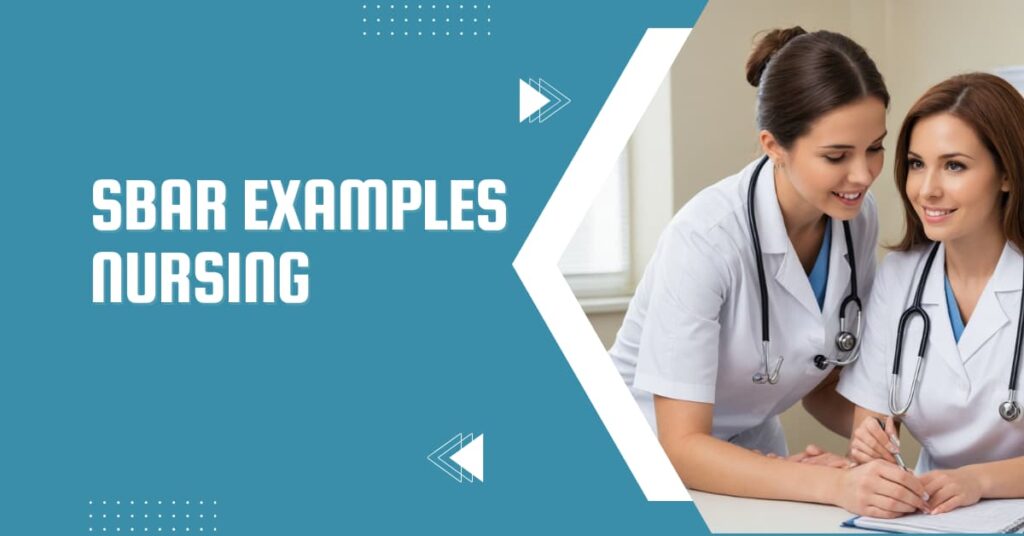Effective communication in nursing ensures that patients get optimal care. SBAR is but a simple technique which nurses use in sharing information. It means Situation, Background, Assessment, and Recommendation. The model was developed to help one be clear in passing information on the condition of the patient in a systematic way. SBAR is a structure for communicating the whole picture regarding a patient’s situation. Be it to the doctor about the condition of the patient or to the time changeover, SBAR makes sure everything of importance is communicated. This technique reduces errors but also eases out the process of communication itself.
In this article you will go through what SBAR is, the importance of SBAR in nursing, and how to apply the technique with practical examples.
Whether you are an early beginner in your nursing career or have enough experience, knowledge of SBAR will help raise your ability to communicate better and improve the patient care process.
What is SBAR?
Table of Contents
ToggleSBAR is also a very basic tool for nurses to communicate key information about patients in a clear manner and format. It simply means Situation, Background, Assessment, and Recommendation.

The method was introduced by the U.S. Navy and spread in healthcare.
SBAR is especially useful in nursing situations that require effective and quick communication. Through this communication model, miscommunication between nurses and doctors is avoided, reducing possible errors and improving the care of patients. What really helps make SBAR so effective is that it is relatively simple. You can use it in a lot of different situations, from dealing with a just-identified urgent patient issue to passing on details during a shift change. SBAR gives clear form to conversations, which enables one to communicate effectively; hence, it is inherent in nursing practice.
When was SBAR first used in nursing?
SBAR was introduced into nursing in 2003. It was actually developed by the U.S. military to clearly communicate on submarines, and it was adopted by health teams at Kaiser Permanente in Colorado to improve patient safety. Since that day, SBAR has been a very useful tool in nursing.
When Is the SBAR Communication Technique Used by Nurses?
It is on this SBAR technique that nurses rely upon to keep their communication simple, yet clear, particularly in essential moments. This technique comes in very handy during admission, transfer to another unit, or when a sudden change in a patient’s condition calls for immediate action. The SBAR helps nurses communicate comfortably with physicians, healthcare teams, and even the family members of their patients. SBAR is also excellent during shift changes, making it easy for nurses to pass on relevant information to the next team.

In emergencies, such as a code, SBAR clarifies the situation to everyone quickly.
Breaking down communication into four simple parts—Situation, Background, Assessment, and Recommendation—SBAR makes things easier for everyone to understand what is going on and what needs to be done. This makes communication much smoother, misunderstanding is avoided, and it allows the health team to work together in providing excellent care.
What really helps make SBAR so effective is that it is relatively simple. You can use it in a lot of different situations, from dealing with a just-identified urgent patient issue to passing on details during a shift change. SBAR gives clear form to conversations, which enables one to communicate effectively; hence, it is inherent in nursing practice.
Useful Tips for Using SBAR in Nursing
The SBAR technique can significantly make communication in nursing clearer and more effective. Here are some easy tips to guide you in using it well
- Think Before You Speak: Before you start talking, take a moment to figure out what really matters. Make sure you properly use the present to confine your discussion to information that others should know about the patient. If you need to call someone or take action, jot down the main points.
- Keep It Clear and Simple: The basic and designed purpose of SBAR is to offer information easily understandable by everyone. Stick to the important facts and don’t bog down with unnecessary detail that might confuse the issue. If someone needs more info, they can ask for it afterwards.
- Teaming Up: Sometimes two heads are better than one for ideas. Don’t hesitate to ask for advice or work together to develop a solid plan.
- There to Answer Questions: Once the main information has been reached, be ready to answer any questions available. This means everyone is on the same page and ready to move forward doing the right thing.
With these tips in mind, using SBAR is easier toward delivering the best care.
Importance of SBAR communication in nursing
SBAR is a really powerful communication tool in nursing that over-energetically ensures patients receive the deserved care. Here’s why it’s so valuable

- Simple and Clear: SBAR provides nurses with a clear way to communicate important details to doctors and other health staff. This assures that nothing of importance will fall through the cracks.
- Improves Teamwork: SBAR helps nurses communicate the issue at hand to the health care team as a whole. This in turn brings about faster decision making and better outcomes for patients.
- Quick Responses: SBAR allows nurses to communicate effectively and efficiently about what is happening to a patient. By using this tool, it enables a team to act quickly and follow up on the right actions. It helps in reducing errors and increasing efficiency.
- Boosts Patient Safety: The use of SBAR reduces the risk associated with errors and delays in treatment, thereby ensuring the safety of patients.
- Closes Communication Gaps: Since both nurses and doctors communicate differently, SBAR allows them to understand each other. This places everybody on the same page.
SBAR is an essential tool in nursing that improves communication, hastens response, and provides safety to patients.
Examples of SBAR in Nursing
The SBAR is quite an easy, but very effective, tool of nursing communication. Here is how to apply it effectively in real-life situations
Example 1: Discharge Shift Report
A nurse is passing on the care of Harriet Brown, a patient who has been in the hospital recovering from a minor car accident.
- Situation: Harriet Brown, who was brought in this morning following a car accident, is stable with no symptoms of a concussion.
- Background: She has remained alert and stable. Her husband is ready and waiting to take her home.
- Assessment: She appears ready to go home.
- Recommendation: Let’s keep her for another 30 minutes and provide her with a pain medication prescription to go home with.
Example 2: Communicating Cardiac Symptoms
A nurse needs to notify a physician that a patient, Omar Nour, is experiencing symptoms that suggest he may be having a cardiac event.
- Situation:Dr. Hinkley, this is Mariah at Waverly Hospital. Mr. Nour is experiencing chest pains and shortness of breath.
- Background: He had shoulder surgery yesterday; his onset of chest pain was one hour ago. His pulse is irregular.
- Assessment:This may be a cardiac event or even a pulmonary embolism.
- Recommendation: Can you come right away? I’m going to start him on oxygen. Do you agree?
Example 3: Possible Pneumonia
A nurse updates a consultant about Mr. Pierce, a patient with symptoms of pneumonia.
- Situation: Mr. Pierce came in today with trouble breathing and possible pneumonia.
- Background: He’s healthy overall, doesn’t smoke and just returned from a trip. Tests have ruled out a blood clot.
- Assessment: His symptoms suggest pneumonia—cough, chest pain, and shortness of breath.
- Recommendation: Shall we repeat the blood tests, obtain a chest X-ray, and institute antibiotics?
These examples show how SBAR improves clarity in health communication and guarantees that all important information is communicated correctly to other colleagues in health care.

Bottom line
One of the most important tools for clear and effective communication in nursing is SBAR. This, therefore, structures the information about a patient into four simple steps: Situation, Background, Assessment, and Recommendation. This structure will help the nurse communicate important information fast without errors and improve care delivered to the patient. This use of SBAR will ensure that everybody is on the same page to enable better outcomes and safer health practices.
FAQs
SBAR: is quite a useful tool in giving a quick, clear communication. It refers to Situation, Background, Assessment, and Recommendation. The SBAR tool can be used for quick updates or handovers of important information. Think of it like being concise, but to the point.
SOAP: is used for detailed notes regarding patient care and means subject, objective, assessment, and plan. This helps you record, in essence, what the patient says—that is, subjective information—and what you observe—that is, objective information—then making your expert judgement, that's an assessment, and what do you intend to do, that's plan. It gives a complete view of the patient's condition and strategy of care.
SBAR is for quick updates, whereas SOAP is detailed.
- Situation: Introduce yourself, your place, and why you have called.
- Background: Identify important facts about the patient and his or her history.
- Assessment: State the patient's condition at this time.
- Recommendations: Provide recommendations on what the next steps should be.
This will help in keeping your communication very simple and brief.


